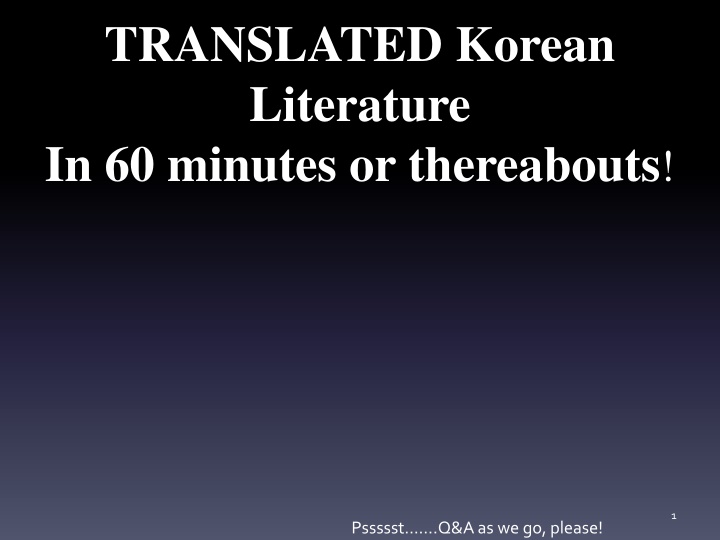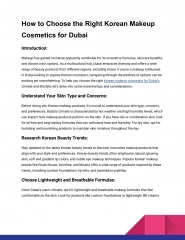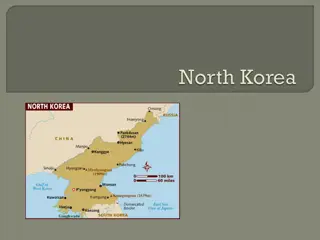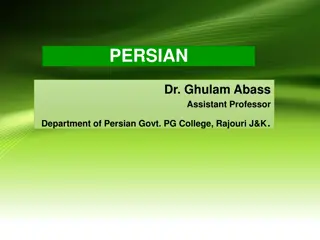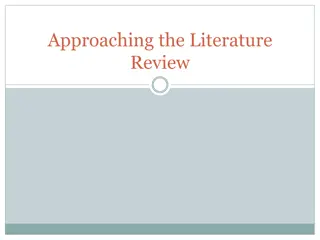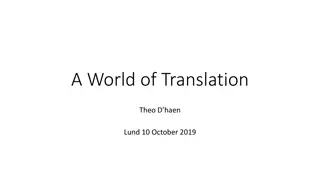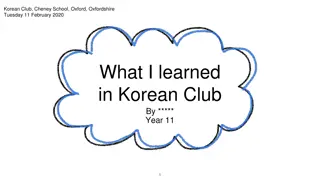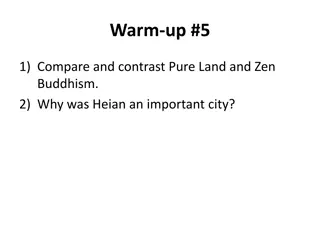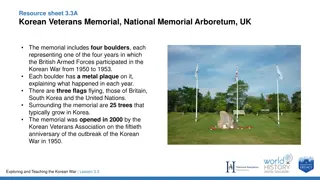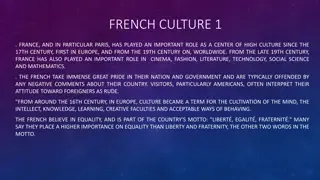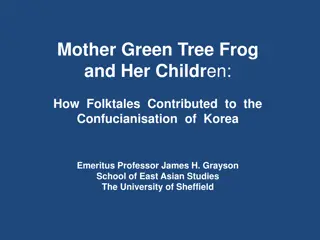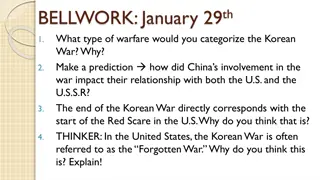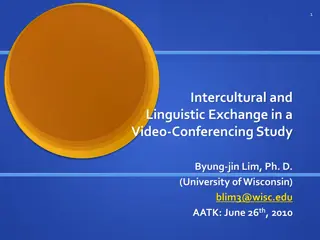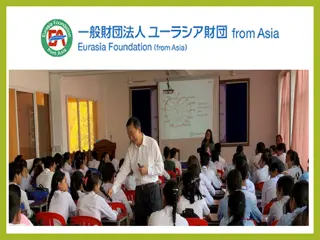Unveiling Korean Literature & Culture
Explore Korean literature's distinctiveness through pre-modern and modern eras, discussing its deep ties with culture and history. Delve into the influences of Shamanism, Buddhism, Confucianism, Taoism, and Christianity on Korean literature. Learn about the unique relationships depicted in Korean society and the emphasis on harmony found in Taoism.
Download Presentation

Please find below an Image/Link to download the presentation.
The content on the website is provided AS IS for your information and personal use only. It may not be sold, licensed, or shared on other websites without obtaining consent from the author.If you encounter any issues during the download, it is possible that the publisher has removed the file from their server.
You are allowed to download the files provided on this website for personal or commercial use, subject to the condition that they are used lawfully. All files are the property of their respective owners.
The content on the website is provided AS IS for your information and personal use only. It may not be sold, licensed, or shared on other websites without obtaining consent from the author.
E N D
Presentation Transcript
TRANSLATED Korean Literature In 60 minutes or thereabouts! 1 Pssssst .Q&A as we go, please!
Who Am I? Associate Professor at Dongguk www.ktlit.com Various projects with LTI Korea Ex marketer Translation Editor Poor Korean 2
What I Will Discuss Why is Korean literature distinctive?^^ Pre-modern and modern periods (and eras within eras within eras) of Korean Literature The strong relationship between Korean Literature and Culture/History 3
To Understand Early Korean Literature 5
Influences Shamanism Buddhism Confucianism Taoism Christianity (but way later) 6
Mediation Spirits Ancestors Nature 8
Next Time! I swear we ll get that incarnation right!^^ 10
5 Relationships 1) Ruler to Subject 2) Father to Son 3) Elder Brother to Younger Brother 4) Husband to Wife 5) Friend to Friend The preceding parts are superior to the antecedent, except for #5 where they're equal IF OF THE SAME AGE. 12
Harmony Emphasizes living in harmony with the way/path. 14
What Does It Add Up To? Balance between emotionalism and control always a question Moral or Dynastic code underlies much of it 15
Oh yeah. China Japan 16
Some Cultural Differences* Very Broad Strokes Adapted from Chinese-born German designer Yang Liu. *That just might influence readers or writers.^^ 17
What Barriers Does this Create? Flat Affect (High Context Fewer heroics) Less Agency (Socially Determined) Gatekeeping Awesome Trauma Levels Didacticism Reduced interest in explicit character motivation Plots less important than message 25
Bad Translation (De) Amplification Different themes/genres Literality Impossibility Bad incoming translation 26
Who Cares? Consider Sonagi ( ) Consider Buckwheat Seasons ( ) Consider Descendants of Cain 27
Literature Dividing Lines Classical (? Late 19th Century) Modern (1900 Now) Post-Modern 28
Literature Dividing Languages Hyangch al Chinese Hangul 29
Koryo Kasa One to thirteen stanzas Stanzas have refrain in the middle/end to establish mood or link the stanzas Informal, bolder, Kisaeng 30
Joseon Kasa Free verse, based on a rhythm of doubled feet with three or four syllables Not stanzas More narrative/descriptive 31
Kasa There is between heaven and earth many a man who s worth as I. Why don t they know the great Joy Of living in the wooded mountains? With a grass hut of a few bays built to face a clear blue stream, In the lush wood of pine and bamboo I am the master of wind and moon. 32
Sijo Joseon poetry shifts to sijo/kasa written by Yangban 3 lines of 14-16 syllables each. Total syllables between 44 and 46 Rules almost always broken, as sijo aren t really syllabic^^ 33
Yi Sun-sin Moon-bright night on Hansan Isle and I sit alone atop the lookout. I hold my great sword by my side, and as my worries deepen, from somewhere comes the single note of the Mongol flute,piercing to the very bowels. 34
Pansori Narrative poetry focused on real life from shamanist chants of S-E Korea in late 17th and early 18th centuries Long narrative musical performance with drummer and singer Literature like Homer spoken first, then written. 35
Korean Classical Literature Oral Therefore often poetic Chinese Characters Full of influences we just discussed 36
Classical Prose Tales of Kumo by Kim Shi-sup in the mid 15th century The Tale Of Hong Gildong by Hyo Kyun in the late 16th or early 17th century 37
Korean Alphabet: Hangul Invented by King Sejong the Great in 1443 14 consonants & 10 vowels "A wise man can acquaint himself with them before the morning is over; a stupid man can learn them in the space of ten days . 38
Country Time 2333 B.C. Go-Joseon 1st century B.C. Three kingdoms (Shilla, Baekje and Goguryeo) 668 935 A.D. Shilla (south: 668-935) Balhae (north: 698-926) 935 - 1392 Goryeo Dynasty 1392 1910 Joseon Dynasty 1910 - 1945 Japanese rule 1945 - 1963 Division 1963 - 1997 Miracle 1997 - Now Post - modern Now -> ? Internationalization 39
Korean Economy - 5 Centuries in 1; Literature 3 in 1 Enlightenment (End of Joseon) Colonial (Three eras) War Separation Industrialization / Modernization Post Modern
Colonialism Forced warped Modernization/Japanization Three eras 1,2,3 Stories of no opportunity The Modern Woman Nature stories Collaboration 41
Hyon Chin-gon One of the fathers of realistic fiction A Lucky Day / Fire A Society that Drives you to Drink Japanese educated Can t find job Tangled up in factionalism 42
Yi Kwangsu 1910-19 (Heartless) attacks Korea's traditions advocates adopting a western worldview. Essays define new literature 20s to 30's becomes dedicated nationalist advocates moral overhaul. Jailed in 36 blames Koreans for being defeatist Dies unresolved 43
Yi-Sang World s Most Interesting Man?^^ Most works during the 1930s Architect/Draftsman 1936 arrested for thought crimes Tubercular/worsens in prison Dies April 17, 1937 44
Yi-Sang: Wings () Alienated semi-schizophrenic narrator Hermetically sealed life Cannot see his situation Longs to get wings 46
WWII and Vietnam How in Heaven's Name: A Novel of World War Two (Cho Chong-nae) The Shadow of Arms (Hwang Sok-Yong) 47
Civil War? Small, local stories No (translated) Gone With the Wind or Naked and the Dead 48
Separation Period / Pundan Munhak (1945-Present) Hwang Sun-won sCranes or his Descendants of Cain. Jo Jung-Rae s The Land of the Banished Hyun Ki-young s Sun iSamch on Hwang Sok-yong sThe Guest 49
Hwang Sun-won: Koreas Dickens Writer, novelist, and poet Began in Colonial Period Refused to write in Japanese went underground 50
